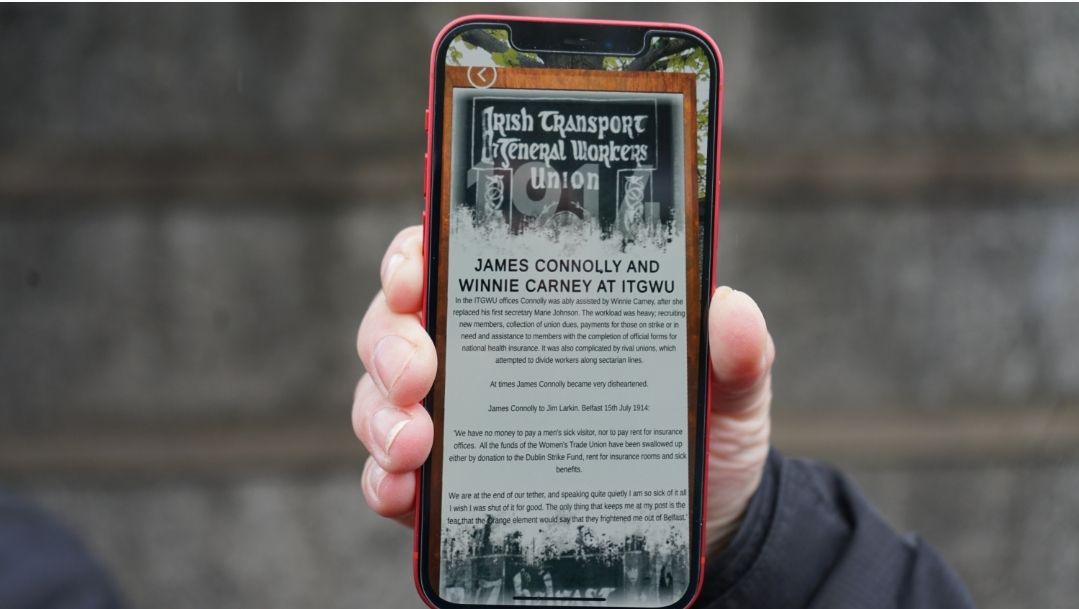THERE was double cause for celebration on Thursday as the highly anticipated beginning of Féile an Phobail saw a first outing on Belfast’s new James Connolly Heritage Trail.
Spearheaded by Áras Uí Chonghaile, the trail uses augmented reality to tell the story of Connolly’s time in Belfast, the city’s workers, and the key events and figures of his day.
When James Connolly faced the firing squad in Kilmainham Gaol for his role in the 1916 Easter Rising, his place in the Irish pantheon was all but secured, with much focus dedicated to that brief period in Dublin.
Though Connolly was a committed anti-imperialist, determined to end British rule, less is said about the fact that he was a dedicated Marxist and socialist revolutionary, who firmly believed in the working class as the agent for its own emancipation. It is, partly, to this latter point that the James Connolly Heritage Trail turns.
Sightseers begin their self-guided journey by downloading a free app onto their smart device which, as well as providing map access, allows them to access information by simply scanning the QR codes at each station. As part of Féile and Phobail, our group also had the benefit of a tour guide in the form of local political activist and Áras Uí Chonghaile’s resident historian, Joe Austin. The weather for yesterday’s tour was inopportune to say the least, but with umbrellas in hand we set out to discover some of the little-known facts about Connolly’s work in Belfast.
The tour begins and the scene is set at Belfast City Hall, built with wealth generated through the exploitation of the city’s workers. In the period straddling the 19th and 20th centuries, Belfast was an industrial powerhouse and bustling port city, notable for the wealth of its capitalist class and for the dire poverty of its workers. It was in this context, in 1911, that Connolly arrives and is appointed Belfast Branch Secretary and Ulster Organiser of the Irish Transport and General Workers Union (ITGWU).
Preparations for an upcoming concert at Custom House Square meant its famous steps, where Connolly and other orators came to speak, was off limits for our tour. However, the next section of the trail, which brought us through Sailortown and the docks, was by far the most intriguing.
A short walk to Rosemary Street brings us to what was Danny McDevitt’s Tailor shop – known as the Bounders College – a hotbed of socialist activity where Connolly once set up office. It was also, reportedly, a port of call for exiled Bolshevik revolutionary Maxim Litvinov, who lived with his sister in Belfast for several years. Invariably described by the Unionist establishment and Nationalist leaders of the day as “cranks” and “soreheads”, the various socialists, anarchists, workers’ organisations, left wing political parties, and union activists, who frequented the College, offer an insight into the political currents and even the rivalries on the left at that time.
Preparations for an upcoming concert at Custom House Square meant its famous steps, where Connolly and other orators came to speak, was off limits for our tour. However, the next section of the trail, which brought us through Sailortown and the docks, was by far the most intriguing.
Amongst the stops is the former site of the ITGWU office on Corporation Street, and the gates of the city’s docks where we learn about the efforts of Connolly and others –including his secretary and confidant Winifred Carney – in organising the dockers there. Those workers and their union leaders were regularly subjected to baton charges by authorities keen to protect the interests of the bosses.
Visiting the former site of ITGWU Office on Corporation Street
But besides being about James Connolly the Heritage Trail is, fittingly, about the workers within whom he saw the means to dismantle capitalism. Our tour guide, who comes from a family of dockers, offered a fascinating insight into the harsh work they undertook.
Just across the street, at site of the York Street Linen Mill – where now stands York Gate Shopping Centre – we hear of horrifying conditions the women there endured. Surrounded by deafening machinery, the women worked barefooted in toxic wastewater given off by the working of flax. For those who owned shoes, this protected them from the corrosive effects of the water – the cost of which they paid with their health and, in many cases, with lives that ended prematurely.
The James Connolly Heritage Trail makes its way up the Falls, stopping at the Conway Mill where we learn more of Winifred Carney’s relationship with the Millies and her role with the Irish Textile Workers’ Union. The building, striking in its own architectural right, was saved from dereliction by community workers of our own time.
Alongside the Conway Mill, Connolly’s former home on Glenalina Terrace is amongst a handful of surviving buildings from that era that feature on the trail. Therefore, it would be an understatement to say that the powers that be in Belfast have been less than diligent in looking after our built heritage. However, in the absence of certain buildings that once were, the use of augmented reality allows tourists to form a concrete image of what Belfast was like during Connolly’s time. The innovative James Connolly Heritage Trail is a testament to what can be achieved with the right research and information.
In connecting with our city’s past, it would be remiss not to consider our present. And in walking the route of the trail, the looming corporate office blocks that crowd the skyline around Sailortown are a stark reminder that society's wealth remains in the hands of the few, and that Connolly’s ultimate objective – the overthrow of capitalism – is yet unfinished. For those who yearn for that emancipatory goal, the story and the politics of Ireland’s foremost Marxist thinker and revolutionary are a must. This trail is as good a start as any.
For more information about the James Connolly Heritage Trail click here.








